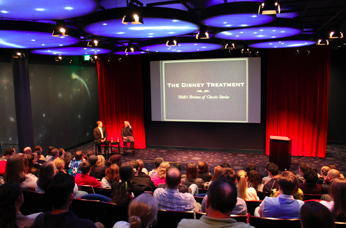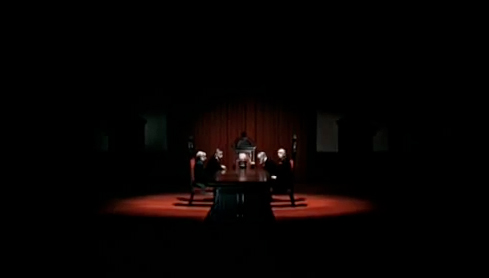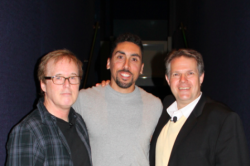On Saturday, May 19, two-time Academy Award®-winning director Brad Bird (The Incredibles, Ratatouille) sat before a packed house at The Walt Disney Family Museum and discussed many of the stories Walt Disney adapted for the big screen. Author and Disney Historian Jeff Kurtti was on hand to moderate, and together the two speakers gave the audience fascinating insight into some of the movies many of us grew up watching. And as Brad so succinctly stated, “Looking back on the legacy of Walt Disney is the gift that keeps on giving.”

The program opened with an opening; the beginning of Snow White and the Seven Dwarfs. Brad pointed out that while Snow White had a very simple opening, it showed what a good storyteller Walt was. When the book of the Snow White fairy tale opens, it has a bit of a “silent movie” approach, with text that audiences have to read. When the Queen’s castle is revealed, Brad noted, “Instead of happy music it begins with mysterious music, which immediately puts you in a different state of mind. The coolest thing is he (Walt) instinctively begins with not only the Queen, but also the mirror. He shows right away she is a slave to her own image.”
The dwarfs also received a Disney makeover, as most of the early adaptations of the Grimm fairy tale portrayed them as thieves, not jewel miners. And the number of dwarfs varied as well. Walt decided that they should be sympathetic characters, all with their own distinct personalities. Brad then marveled over the scene in which the Queen conducts her self-transformation. “To me this is ‘Exhibit A’ that this movie can match any live-action film,” he said. “It has a little bit of that silent movie feel—she’s telling you an awful lot for a woman who’s alone in the room, but I’ll put this up against anything else that was going on at the time.”
Moving from a well-known fairy tale to a relatively obscure children’s book, Brad and Jeff spoke to us about a puppet. “The appeal of Pinocchio was that he was mischievous, always getting into trouble,” Brad revealed. “The arc of the story is for him to not be like that. In the book, Pinocchio squashes the cricket.” In the original story, the cricket wasn’t appointed to watch over Pinocchio. And upon providing the little wooden boy with a single piece of advice, Pinocchio hurled a hammer at it, killing it.
 Brad continued, “Suddenly they hit upon the fact that since Pinocchio was trying to be good, they could create this character to help him. To act as his conscience. What’s cool is that Jiminy Cricket is kind of a vagabond. He has spats, but they’re worn out. And Jiminy didn’t think of himself as a vagabond.” (That is another variation on the cricket. In the original story, it lived in the house for over 100 years.) “You can see very quickly once they had that idea, it became the thing. They put him in the opening. And he’s not perfect either, he makes mistakes.”
Brad continued, “Suddenly they hit upon the fact that since Pinocchio was trying to be good, they could create this character to help him. To act as his conscience. What’s cool is that Jiminy Cricket is kind of a vagabond. He has spats, but they’re worn out. And Jiminy didn’t think of himself as a vagabond.” (That is another variation on the cricket. In the original story, it lived in the house for over 100 years.) “You can see very quickly once they had that idea, it became the thing. They put him in the opening. And he’s not perfect either, he makes mistakes.”
Brad then showed us Pinocchio’s incredible opening scene. Like Snow White, the storybook opens, only this time with a little help from Jiminy. The camera zooms in on a picture of the night sky over an Italian village, and zooms out to reveal we are located in said village. The score is synchronized with the action onscreen, as we hop along from Jiminy’s point of view towards Geppetto’s quaint little shop. Many people to this day (myself included) consider Pinocchio to be the greatest animated film in history.
Other books of varying fame and popularity, including Bambi and Winnie the Pooh were adapted by Walt, but Jeff observed that, “One of Walt’s most skillful literary adaptations was Mary Poppins.”
“In the books she’s different,” Brad added. “Less humor, more strict. It’s wonderful, it’s very British. But in terms of making it a movie, a lot didn’t work.”
“It’s interesting to see what Walt saw in it,” Jeff replied.
“Well, his daughters liked it,” Brad chuckled. “They were always amused by it.”
In 1960, Walt Disney gave a copy of author P.L. Travers’ tale of a British nanny to the Sherman brothers with the intention of making, “The greatest musical fantasy of all time." So Richard and Robert Sherman went through their copy, and underlined the chapters that they felt were particularly musical. When they handed their notes to Walt, he pulled out his copy of the book, and he had underlined the exact same chapters.
“The heart of the story is about absentee parents,” Brad said. “Children are an obligation, a bother. The parents are absent for different reasons. The father works tirelessly at the bank, and the mother is a suffragette.” Brad then set up a clip for us. “Mary Poppins sees the problem very clearly.” Brad went on to explain how after Mr. Banks was tricked into taking his children to work with him, subsequently causing a run on the bank, he was later called back to work to be properly discharged. And when Mr. Banks opened the door to the bank’s bleak, scantly lighted boardroom, Brad observed, “This is Disney’s take on banks.”
 Bank scene from Mary Poppins. © Disney.“Walt’s relationship with his father and his feeling towards banks was shown a lot in Mary Poppins, Brad stated. “Walt’s father Elias was a workaholic. So was Walt, but of course Walt was more successful. That’s something Walt struggled with also. Working all the time, but still making time for his children.”
Bank scene from Mary Poppins. © Disney.“Walt’s relationship with his father and his feeling towards banks was shown a lot in Mary Poppins, Brad stated. “Walt’s father Elias was a workaholic. So was Walt, but of course Walt was more successful. That’s something Walt struggled with also. Working all the time, but still making time for his children.”
Brad and Jeff moved on to films derived from older-skewing adventure literature such as Kidnapped, Swiss Family Robinson, In Search of the Castaways, and Walt’s first live-action literary adaptation, Treasure Island. “No one remembers the other versions of Long John Silver,” Brad remarked. “The way people imitate pirates these days is…show the clip please.” The audience then witnessed the one-legged Long John Silver talking to young Jim Hawkins, donning his deep red restoration greatcoat and tri-corner hat, his dialogue peppered with “Matey” and “Arrrrr.” Brad followed with his own, “Arrrrr,” to everyone’s enjoyment, and went on to say, “That’s the guy we’re imitating.”
The pinnacle of Walt’s live-action adventure adaptations was 20,000 Leagues Under the Sea, and although the pair acknowledged the unforgettable production design and stellar Hollywood cast, they agreed that it was the remarkably adult screenplay and intelligent direction that have made the film timeless. (The film was directed by Richard Fleischer, who happened to be the son of one of Disney’s biggest competitors, Max Fleischer. Also, Richard had yet to direct a big Hollywood feature. Walt relieved Richard’s concerns, advising him that he was hired because he was the best man for the job.) Leagues was quite an amazing film to have come from Walt’s “cartoon studio.” And Brad set up a bleak, emotional scene from the film for us, revealing the villainous Captain Nemo’s humane core.
“This is not a spectacular clip visually,” Brad said. “But it does show Disney wasn’t afraid to get dark and pay full attention to the story.” The scene depicted Nemo talking about a ship he just sank by ramming it with the Nautilus. “He’s not afraid to go for that moment.”
All too soon, Brad and Jeff brought us to the final film of the presentation. “In terms of the most bulletproof adaptation,” Brad said, “It’s Cinderella. But they didn’t make her a sad character talking to herself. They gave her pals,” referring to the mice, birds, and farmyard animals that make up her friends, and serve as “familiars” for the audience’s emotional understanding of Cinderella.
He went on to detail the scene in which the Duke has to confess to the King that he has let Cinderella get away, and how the King wanted to kill the Duke for it. But after hearing that the prince would readily marry this girl, he declared that they would find her (the King really wanted some grandchildren!).
“In the original story,” Brad pointed out, “They find Cinderella, the stepsisters mock her, the shoe fits, and that’s it. But look at what Disney does!” After the animals free Cinderella from her locked room, she barely catches the Duke before he leaves. The evil stepmother then trips the Royal servant, who was carrying the slipper, and we all watch helplessly as it falls to the floor and shatters. But our heartbreak doesn’t last long. “The audience forgets that she has the other slipper.” Brad said. “For me that’s the perfect way to end the show."
While that did in fact end the presentation, Brad wasn’t through entertaining us. During Q&A an audience member asked if he wouldn’t mind showing us one of his alter egos. “You want Edna, dah-ling,” Brad said in his delightful Edna Mode voice. About to take the next question, the woman in the audience quickly asked, “Is that it?” “What do you want me to do dah-ling,” Edna responded. “I don’t perform like a monkey for you!”
Brad Bird’s sense of humor during the afternoon was surpassed only by his knowledge of Disney adaptations, as well as cinema in general.
Jeff’s erudite moderation was the perfect complement, allowing for the two to engage with one another, as well as engage the audience with their intriguing perspectives on the wonderful world of Disney film. Jeff closed by stating how Walt Disney is still influencing filmmakers to this day, while gesturing toward Brad. And based and the quality of Mr. Bird’s work, I think it’s safe to say Walt would be proud.

Keith Gluck (pictured here with Brad Bird and Jeff Kurtti) is a WDFM volunteer, writer/editor for thedisneyproject.com, a Disney fan site. His Disney life started early, visiting Disneyland before turning one, and writing his very first book report on a Walt Disney biography for kids.
